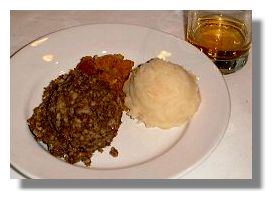Traditional Scottish Recipes
- Haggis
One cookery book I came across suggested that the best way to get haggis was to buy it in the butcher's shop! Certainly, these days haggis can even be ordered online (see the Rampant Scotland Food Links). Finding a butcher who can supply sheep's heart, lungs and liver may not be easy although nowadays beef bung (intestine) is used instead of sheep's stomach. Since this is used also to make European sausage, they are out there for other nationalities as well.
If you find it difficult to obtain a beef bung from a butcher you can obtain a "haggis making kit" from "Sous-chef" via Haggis Making Kit which has enough to make five ½lb haggises (or one 2 ½lb haggis). The company delivers across the UK and Europe. Elsewhere, the search engines should come up with a suitable source in your part of the world.
 It is a shame that the "Great chieftain o' the puddin' race" should be regarded (by some) with such a mixture of horror and humour. The vision of sheep's stomachs and other intestines seems to put some people off, but it has long been a traditional way of using up parts of the animal which otherwise might go to waste. Made properly, it is a tasty, wholesome dish, with every chef creating his or her own recipe to get the flavour and texture (dry or moist) that suits them. Personally, I like a haggis which is spicy from pepper and herbs, with a lingering flavour on the palate after it has been consumed.
It is a shame that the "Great chieftain o' the puddin' race" should be regarded (by some) with such a mixture of horror and humour. The vision of sheep's stomachs and other intestines seems to put some people off, but it has long been a traditional way of using up parts of the animal which otherwise might go to waste. Made properly, it is a tasty, wholesome dish, with every chef creating his or her own recipe to get the flavour and texture (dry or moist) that suits them. Personally, I like a haggis which is spicy from pepper and herbs, with a lingering flavour on the palate after it has been consumed.
Ingredients:Return to the Index of Traditional Scottish Recipes
Set of sheep's heart, lungs and liver (cleaned by a butcher)
One beef bung
3 cups finely chopped suet
One cup medium ground oatmeal
Two medium onions, finely chopped
One cup beef stock
One teaspoon salt
½ teaspoon pepper
One teaspoon nutmeg
½ teaspoon maceMethod:
Trim off any excess fat and sinew from the sheep's intestine and, if present, discard the windpipe. Place in a large pan, cover with water and bring to the boil. Reduce the heat and simmer for an hour or possibly longer to ensure that they are all tender. Drain and cool.
Some chefs toast the oatmeal in an oven until it is thoroughly dried out (but not browned or burnt!)
Finely chop the meat and combine in a large bowl with the suet, oatmeal, finely chopped onions, beef stock, salt, pepper, nutmeg and mace. Make sure the ingredients are mixed well. Stuff the meat and spices mixture into the beef bung which should be over half full. Then press out the air and tie the open ends tightly with string. Make sure that you leave room for the mixture to expand or else it may burst while cooking. If it looks as though it may do that, prick with a sharp needle to reduce the pressure.
Place in a pot and cover with water. Bring to the boil and immediately reduce the heat and simmer, covered, for three hours. Avoid boiling vigorously to avoid bursting the skin.
Serve hot with "champit tatties and bashit neeps" (mashed/creamed potato and turnip/swede). For added flavour, you can add some nutmeg to the potatoes and allspice to the turnip/swede. Some people like to pour a little whisky over their haggis - Drambuie is even better! Don't go overboard on this or you'll make the haggis cold. At Burns Suppers, the haggis is traditionally piped in and Burns' "Address to the Haggis" recited over it.



